
Motor Sport's best 2025 onboards: F1, MotoGP and NASCAR
From Japan to Mexico, Surfers Paradise and Milwaukee, we chart the best onboard racing shots caught in 2025

Red Bull RB15 wheel rim
DPPI
A decade when only two teams have won world championships, amid tight technical restrictions, doesn’t offer the greatest promise when it comes to engineering innovations.
But over the past decade, Formula 1’s greatest minds have devised all manner of ingenious, crafty and cunning designs that skirt the rules and dive through loopholes, upholding the series’ reputation as the pinnacle of engineering excellence in motor sport.
The range of technical treats could fill a book let alone a single article, so we have narrowed down the field with a deeper dive to those that were trend setting or opened up new areas of performance development.
Seventy years since the first Formula 1 World Championship race and we are celebrating the anniversary with a string of features, polls, galleries and archive race reports, to tell the full story of the world’s greatest motor racing series.
Read the decade-by-decade story of the championship by motor racing’s best, in the May edition of the magazine, and click below for the latest online coverage
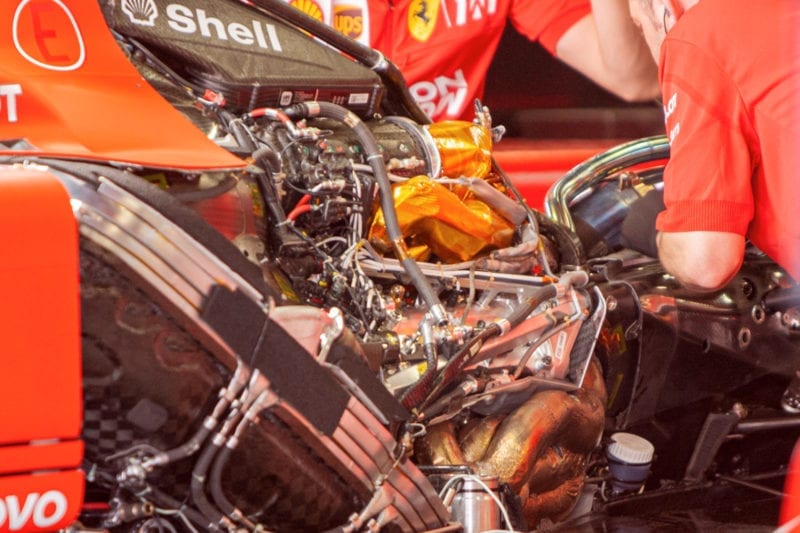
The Ferrari power unit
Undeniably, the biggest innovation to hit Formula 1 in the last decade was the new engine rules package in 2014.
Though much maligned by some, there can be no denying that the current generation of power units are technical marvels, which have pushed internal combustion engine technology far beyond where many within the industry thought was possible. To put their potency into perspective, even the least powerful engine on the grid is making over 830bhp (around 1000bhp when the 161bhp from the MGU-K is added), from just 1.6 litres, yet can last, theoretically, seven races.
As Mercedes’ Andy Cowell summed up during pre-season testing this year. “With the Formula 1 engines we raced with in 2013, the V8s, typically, about 29 per cent of the energy we put in was turned into useful work, with a huge amount going down the exhaust. In the good old days, they used to say a third of the energy would be used for useful work, a third would go down the exhaust and a third would go into the coolant.
“Since the regulation change in 2014, the fuel flow rate became what matters, and the machine that turns the most [available] energy into useful work will be the most powerful engine. We targeted 40 per cent efficiency in Melbourne 2014, which was classed as impossible by many. But the group of people you find in this pitlane, they like that sort of challenge. We actually went racing with 44 per cent thermal efficiency and year by year improvements mean we are now over 50 per cent efficiency.”
It is impossible to highlight every aspect of what makes a modern F1 power unit so special, and many of the truly innovative features will remain secret for some time yet. However, there are a couple of standout innovations.
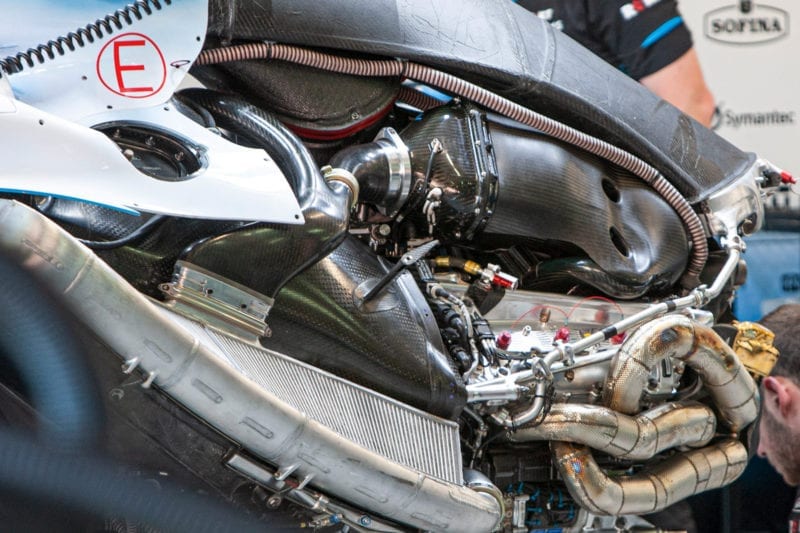
The Mercedes power unit in the Williams
At the top of the pile must be Mercedes’ (at the time unique) approach to the layout of its power unit. Unlike its competitors, Renault, Ferrari and later Honda, Mercedes split its turbocharger and MGU-H (Motor Generator Unit Heat), placing the compressor section of the turbo at the front of the engine, the MGU in the vee and the turbine to the rear. The other two manufacturers placed the entire turbo assembly at the rear of the engine, with the MGU nestled in the vee. There were, it seems, two clear benefits to Mercedes approach.
First, having the compressor at the front of the engine allowed for a much larger unit to be fitted as there is more space than at the rear of the engine, where the neck of the body’s coke bottle form starts to narrow. A bigger compressor means greater efficiency and thus power.
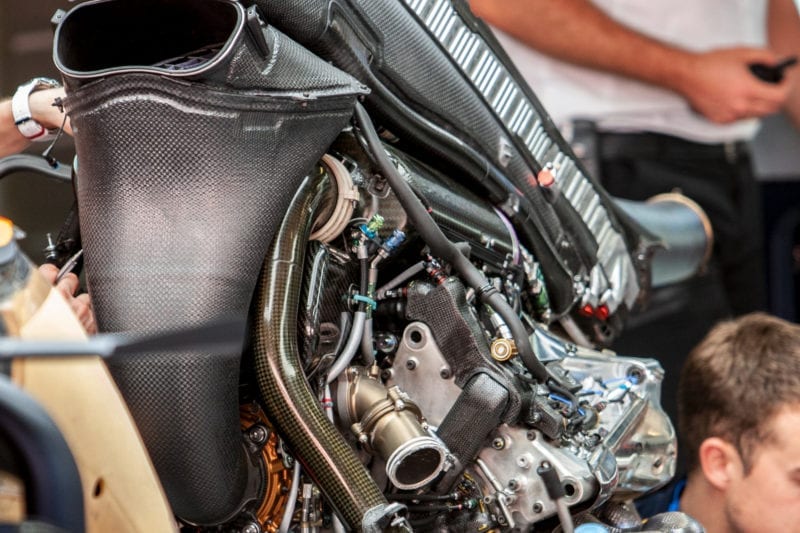
The Honda power unit from 2017 took cues from the Mercedes design philosophy
The layout also separates the hot and cold sides of the turbo, reducing heat soak into the inlet charge, again aiding efficiency (less heat in the inlet air means a smaller charge-cooler can be used, with a knock-on effect to aero). Doubtless, there are other benefits, but Mercedes has always remained tight lipped on these, however, given Honda’s adoption of a similar approach from 2017 on, they are clearly worthwhile.
Splitting the turbo does not come without significant challenges, for example, it requires a very long shaft joining the compressor, MGU-H and turbine. Keeping this shaft stable, while spinning at 125,000rpm, is no mean feat and, according to Cowell, took a huge amount of R&D to perfect.
Another noteworthy development across the board are the trick ignition systems now used by all power unit manufacturers. Referred to by various terms such as pre-chamber ignition and Turbulent Jet Ignition (a Mahle brand name), these all seek to improve combustion stability at very lean air/fuel ratios.
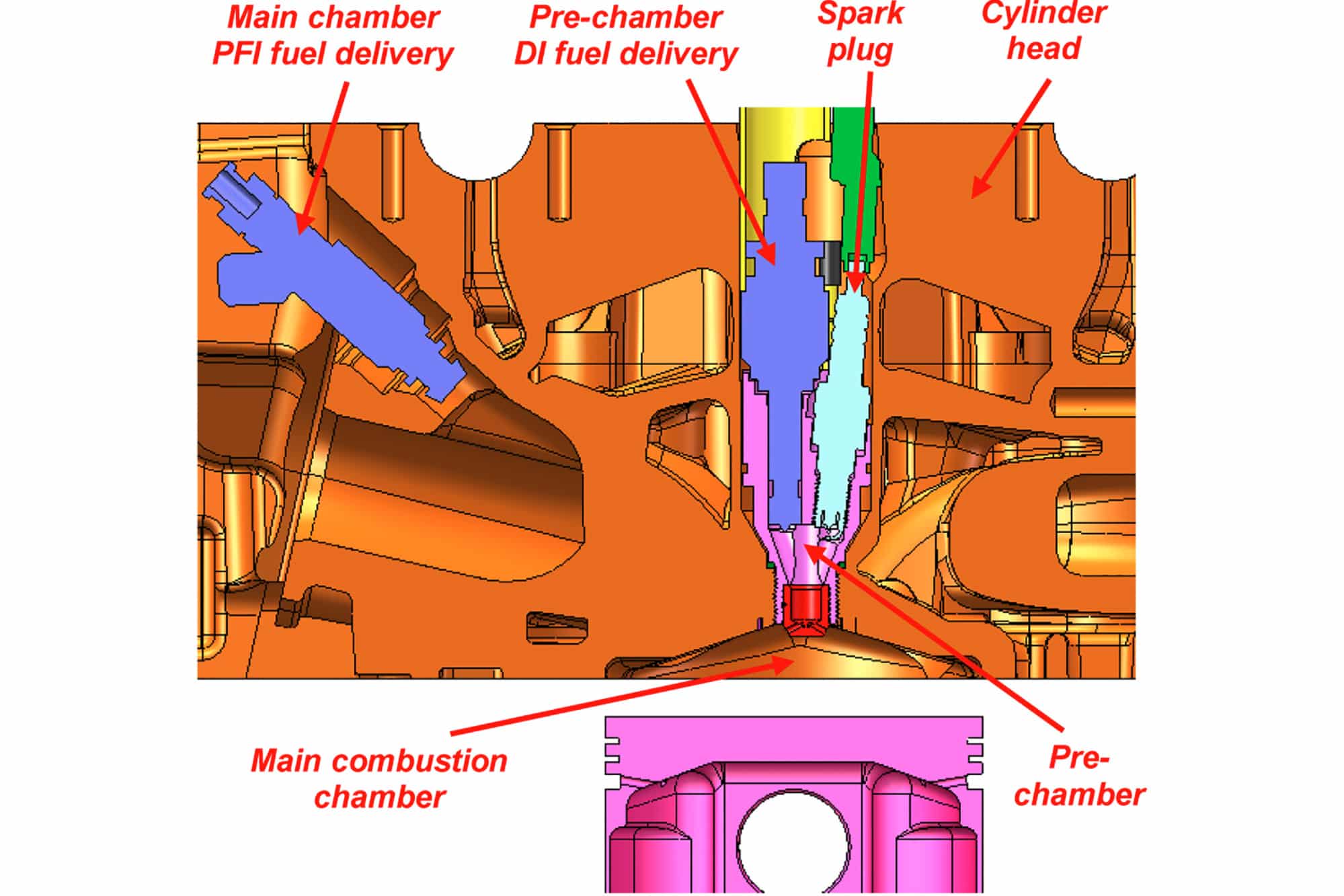
Massively simplifying a highly complex combustion process, the idea is to run the engine as lean as possible, with a far greater ratio of air to fuel than in a normal engine. The problem is, very lean mixtures can be unstable and, if they ignite in an uncontrolled fashion, cause detonation, also known as knock. As Cowell noted, “what you aspire to do is put the [fuel] droplets in exactly the right place in the chamber for the best possible combustion process; which is fast and controlled. If you have fast and uncontrolled, that can result in a broken engine.”
The ideal situation would be to ignite all of the mixture simultaneously; however, apart from being nigh on impossible, the rules dictate only a single spark plug and injector are allowed. Pre-chamber ignition achieves the next best thing. The spark plug sits in a small chamber which can also include the injector (though not necessarily, in its 919 LM P1 car, Porsche used a passive pre-chamber ignition system with the injector in the main combustion chamber).
The mixture in this chamber is richer than the rest of the cylinder and, at the ideal point in the piston’s stroke is ignited by the plug, shooting high energy jets of flame into the main combustion chamber, creating a quick and stable burn. The idea is not a new one, it has been around in industrial applications for decades, but its use in race engines, running in excess of 11,000 rpm, certainly gets it an innovation gold star.

The front-facing exhaust system on the Renault R31
Moving away from engines one gets to the evergreen subject of aerodynamics. Ever since rule makers started to formulate regulations to peg back aerodynamic performance, engineers have been finding ways to bend them, and the last decade of Formula 1 has been no different. There are a multitude of different tricks and tweaks that have appeared on track, but some stand out as bolder, or more ingenious than others.
Rewinding back to 2010, and early in the year, the FIA decided that double diffusers would be banned as of the end of the season. Teams were understandably keen to claw back as much performance as possible post this rule changes, and one method to do this was by exhaust blowing of the diffuser.
To be clear, this was not in the form of directly energising the flow through the diffuser using the exhaust gases (this practice was banned in 1994, though some efforts were made to blow the double diffusers). Instead, it saw the use of exhaust flow to seal the sides of the diffuser, allowing for the car to be highly raked front to rear, effectively increasing the size of the diffuser. Adrian Newey, with the Red Bull RB7 of 2011, was one of the pioneers of the approach.
The technique involved directing the exhaust flow towards the sides of the diffuser, where the turbulent air coming from the tyre contact patch, referred to by Newey as tyre squish, robbed performance. If channelled properly, the plume of exhaust gas would block this dirty air and allow a much higher rear ride height to be run.
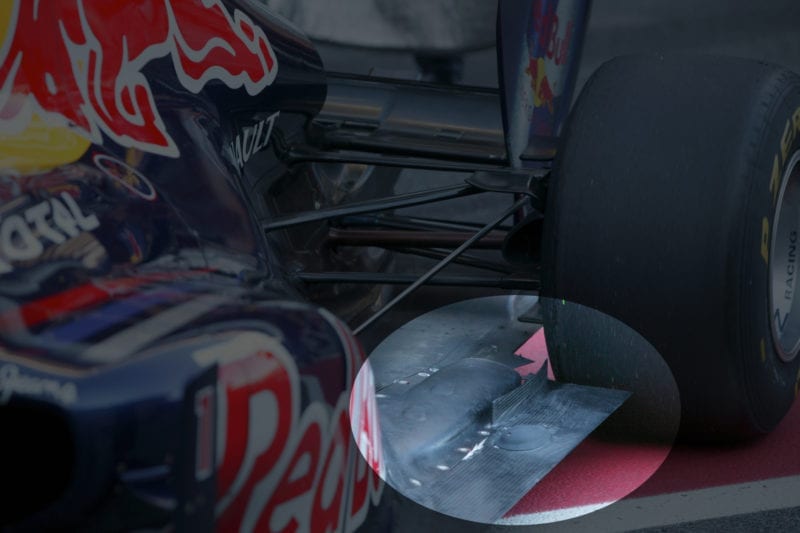
Detail at the rear of the RB7 was crucial in unlocking its immense performance in 2011
Red Bull’s efforts were successful and, as Newey states in his autobiography, How to build a car, “Once we got it working, the downforce gains were absolutely huge, to the point where with the exhaust blowing hard, we were back up to where we’d been with the double diffuser in low speed corners.”
Other teams tried similar ideas that year, notably Ferrari and McLaren, but Renault took a very different interpretation of the theme that was certainly innovative. The Renault R31 featured a front exit exhaust system, which blew the exhaust gases out below the sidepod inlets, into the powerful front floor area, helping to energise the flow under the car.
Renault was also, as engine supplier to Red Bull, instrumental in ensuring the effectiveness of RBR’s exhaust blown diffuser. The problem with exhaust blowing is that it only works when the driver is on the throttle, which they are not during the vital braking and entry phase of a corner, where downforce is most needed. Renault, at the request of Newey, returned to an idea it had trialled in the early ’90s (with Williams) of mapping the engine to keep exhaust gases flowing, even off throttle.
In very simplistic terms, this involved the continued injection of fuel into the engine off-throttle, coupled with retarding the ignition timing and cutting ignition to certain cylinders. The result being fuel ignited in the exhaust port, not the chamber, keeping exhaust gas energy high, but not pushing the pistons down. This process became known as hot-blowing and, according to Newey, Renault, “did a superb job of blending cylinder cut, ignition timing and throttle position…it was the key to our success in the 2011 season.”
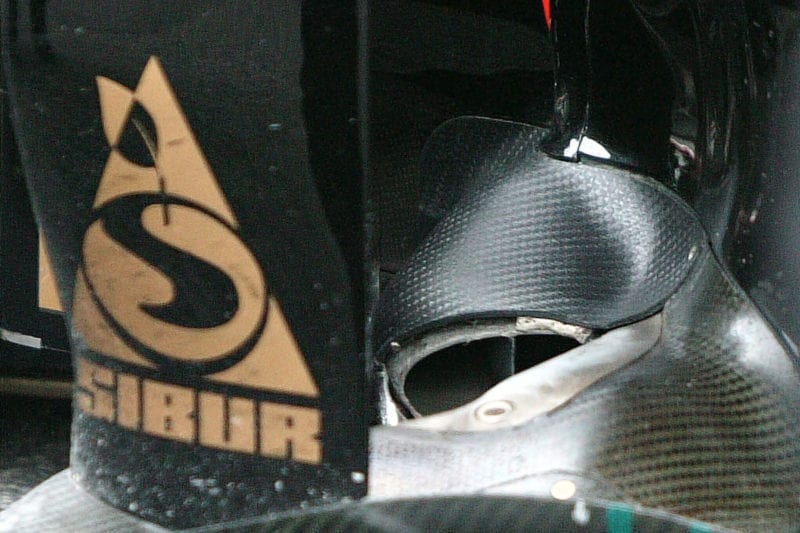
The Renault exhaust outlet ahead of the sidepod intake
As with so many innovations, teams that couldn’t master this method of exhaust blowing moaned to the FIA and for 2012, solutions such as Red Bull’s were banned. Fortunately, as is so often the case, this just pushed engineers to be even more inventive in trying to replicate the performance gains they had found. Enter the Coanda effect exhaust.
With new rules that dictated the position of the exhaust outlets away from the rear floor, several teams, including Red Bull, looked at how they could still direct the exhaust gases where they wanted them.
The answer would be in a phenomenon identified in the early 20th century by Romanian aeronautical engineer, Henri Coanda. He discovered that a fluid jet, be it air or liquid, would attach itself to a nearby surface and remain attached, even if the surface curved away from the jet’s initial direction.
F1 teams harnessed this to steer the exhaust gases back to the sides of the rear diffuser, using carefully shaped sections of bodywork. They had varying levels of success and the challenges, particularly when it came to stopping bodywork catching fire, were considerable.
However, if it could be made to work, it was ferociously effective. For McLaren, which had struggled with its diffuser blowing in 2011, harnessed Coanda very effectively for 2012. In 2010, while testing the next year’s MP4-25, the team discovered that the exhaust flow it was trying to direct to the edge of the floor was being drawn inboard.
Its CFD and wind tunnel sims hadn’t picked up on this and it was only track testing that showed it up; the underlying reason was the Coanda effect. It then spent the next 18 months refining its simulation tools to model Coanda and so, when direct blowing was banned, it was ideally placed to understand and harness the effect to its benefit.
As McLaren principal composites engineer Steve Foster, who worked on the project, explained in 2020, “the FIA was unaware of what we had learnt through our travails with the MP4-25 in 2010. Having evolved our CFD and wind tunnel tools to properly replicate the Coanda effect, we knew we could use the phenomenon to our advantage. We developed these slides that sucked the exhaust gases fired out of the tailpipe down towards the floor, mimicking the effect of what we had been doing the year before with low-exit exhausts.
“We eagerly waited to see if any of our rivals unveiled a car with a similar concept. And, to our surprise, none of them did. We had stolen a march on the opposition and went on to lock out the front row and take victory at the season opener.”
McLaren was not the only team to recognise the benefits of Coanda – Red Bull had a very similar solution on the RB8 – but it was the first to make it work properly. In Red Bull’s case, Newey admitted that it hadn’t accounted for the effect of pulses in the exhaust gas flows, thanks to its earlier work, McLaren’s engineers were well aware of this problem.
The above is a detailed look at just a few of the standout innovations of the past decade but there are, of course, many others. The work done by teams on flexible aero devices, which allow sections of bodywork (wing elements in particular) to deform at speed, reducing drag, is fascinating, but still a touchy subject when it comes to disclosing details. Engineering parts to behave like this consistently, while still passing the FIA’s various deflection tests is a supremely complex task.
Sticking with aero, I feel special mention should be given to the practice of blowing air through the front axles, to help drive outwash away from the aerodynamically sensitive centre of a car. Again, Red Bull were a pioneer of this approach, but what is fascinating to me is the knock-on developments this caused, not least in wheel nut design. This is explained in an excellent video from Red Bull below.
One could also spend days looking at the various trick suspension solutions that have arrived since 2010, the various permutations of front to rear interconnected suspension (FRICS), Ferrari’s pull rod front suspension or Mercedes’ and others use of hydraulic rather than traditional torsion springs. But we’ll have to save those for another time.

From Japan to Mexico, Surfers Paradise and Milwaukee, we chart the best onboard racing shots caught in 2025

F1’s 2025 world championship delivered edge-of-the-seat drama and unpredictable twists - and you’ve chosen the standout moments that defined the year

As Sauber prepares to disappear from the Formula 1 entry list and evolve into Audi, we look back at the Hinwil team's defining moments

Here’s a breakdown of the 2026 Formula 1 grid, where every seat is already set but the rules reset is quietly shaping the next phase of the silly season